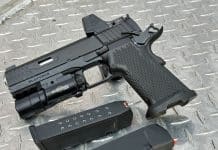[dcs_img_center
framed=”no” w=”600″ h=”294″]
http://gunsandtactics.wpengine.com/wp-content/uploads/2013/08/wes-600-294.jpg
[/dcs_img_center]
[dcs_post_top]
[dcs_fancy_header color=”#000000″ fweight=”bold”]Part III in a series of posts from Khyber’s Wes Doss on the realities of training.[/dcs_fancy_header]
[dcs_thinspliter size=”medium”]
Those who understand the realities of conflict, by either experience or through training, know that there are a lot of variables that reduce each and every situation to a full blown back alley crap shoot. Why? You may ask, because unlike the anti-reality world a real world event provides for a vastly different perspective on reality and will vary greatly from situation to situation and will change significantly every second that it’s allowed to evolve, as true conflict is an ever-changing, fluid environment with no set solutions. Knowing this before getting knee deep in a contest of might is crucial.
In the training environment, you are generally the only part of the equation that has a weapon, at least a real weapon. The one dimensional “opponent” found on most ranges won’t pull a knife, won’t bum rush you and won’t pull a gun and shoot you. Additionally, you generally don’t face more than one target at a time, and your “opponent” won’t have any friends that will attack while you’re focused on the single situation. Further, most real world situations don’t start with the sound of whistle or other start signal. A real life encounter is likely to start with some form of physical posturing or with some form of initial dialog, either aggressive or deceptive. This is seldom replicated in training.
The training environment represents a controlled environment, absent of loose gravel, broken glass, knee gouging concrete and bottle throwing audience members. You seldom face slippery, wet or icy surfaces on a training range. Blizzards, rain, winds, sand storms and visibility are all real world realities that are not typically part of the training world. Along with natural environmental conditions, the training world seldom places the student in the linear confines of a bus or subway car or exposes the student to the hazards of city traffic or the dangers of hot metro line tracks.
The average student arrives at the range like he walked out of the pages of some zombie apocalyptic gear catalog, dressed and equipped with all the right gear, the stuff most of us never see in the field. Wearing all the fashionably tactical clothing, thus eliminating clothing as a variable that would restrict ability. We don’t typically train in a suit or a skirt and heels. Most classes won’t require the use of winter gloves or heavy winter coats. Additionally, I have yet to see a tactical “reality based” course where the students train like they are carrying their infant child or walking with your wife or mother. These are real world concerns and real world events that happen daily in the lives of all of us, and will significantly alter our perception of a conflict and limit the options that are available to us. Our own personal well being is seldom a training issue. If you’re sick, hung over or desperately trying to run on limited sleep you simply cancel training. Unfortunately, it’s not possible to cancel the real world, once you’ve started your stuck there until the fat lady takes a bow.
The training world is always preemptive and predictable, in that I mean that no matter how realistic a training session, the student always knows it’s a training session. We are made aware when and at what time training will start and finish. Students know that targets are lifeless one dimensional object, they are told how many rounds to load and how many extra rounds to carry, and they know they are scheduled for training thus giving them the opportunity to prepare days, weeks or even months in advance. To top it all, in the training world when the stress and pressure get too high, you can just tap out, stop or call for a time out with no worries of injury or death. This can foster a serious degree of complacency in the student’s mindset.
The reality, the real reality, of self defense and martial situations is that we are not always in control. Though we should work to gain and exploit control, we may not always initially find ourselves in control. There are people in this world who will try their damnedest to hurt you and for the most part you won’t know who they are or when they will launch their attack. It is imperative to understand all the facets of conflict and to be prepared with the most realistic practice that we can muster. In training realistically we will develop knowledge of our own limitations and the limitations of the tools we have chosen to use or have on hand, as well as the mechanics and logistics of their use. Those who are ignorant of these things will mock and write off the value that such training and preparation provides, thus remaining much less prepared to do what needs to be done, when its time to do it in a real conflict. Training for conflict and practicing for fun or competition are distinctly separate issues and therefore need separate training methods; this can not be emphasized enough. The notion that all we have to do is acquire a basic set of skills is one that truly suits those who would do us harm. Armed with this type of over confidence, the unprepared student of self defense is potential silage for the perpetrators of violent aggression, being easily manipulated in an environment dominated by these individuals. How do we fix this? The answer lies in getting off the square range and taking our training to our imagination. Look at the world around us, listening to the experiences of others and embracing the concept of reality. My message to all, as always… Train to Win! Expect to Win!
[dcs_thinspliter size=”medium”]
Read Part I: Reality… What a concept!
Read Part II: The Training World vs. The Real World
[dcs_thinspliter size=”medium”]
[dcs_post_bottom]
[dcs_post_author]
[dcs_related_posts]













We actually do have a 25lb. dummy “child”, that students carry and defend during some our courses!
You’re right that reality is hard to simulate, and that most “tactical” courses and instructors pay reality little more than lip service (or marketing tag lines).
My instructors and I do try to add as much reality as possible, and you’ve actually given me a couple of new ideas to test out. Thanks!
Comments are closed.